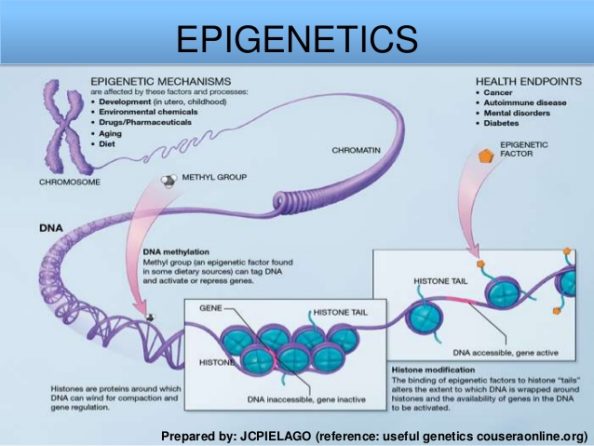Epigenetics part 1
Let’s begin with a few definitions. Genetics is the study of all the hereditary material(DNA) in our cells. DNA is organized into unique sequences called genes and all of roughly 23000 genes that each human cell contains are neatly packaged in our cells into structures called chromosomes. Genes are responsible for traits such as hair color or our height. In addition to DNA(the hereditary material) our chromosomes also contain other material, non-DNA sequences which act like switches. These “switches” control which genes are expressed and which genes stay silent.
Epi means near, upon or at. So epigenetics is the study of these non-DNA sequences which are near the genes(DNA sequences) that can modify and control gene expression. They do this by various mechanisms, but one way this is accomplished is by DNA methylation. If you add a methyl group at the end of a DNA sequence(gene), it effectively shuts off that gene, and it you remove the methyl group from that gene, then that particular gene is activated.
Ultimately, genes dictate which protein the cell will make. During the maturation of a cell, if one set of genes are activated, different set of proteins are made and the adult or mature cell may become a kidney cell, but if different set of genes are activated, different proteins are made and the mature cell may become a skin cell. Just as we inherit our genes from our parents, the “switching sequence” that decide which genes turn on and which genes turn off at precise moments is also inherited. But here is the crucial difference, we have no control over our genes, we get the genes from our parents, but this “switching sequence” is modifiable. This is a clever system devised by nature to allow us to be adaptable to our environment. This mechanism comes in handy when we live in different environments. The subcutaneous fat in our body, its amount and its type varies by the season. In the summer, fat cells may produce mostly “white adipose tissue” but as the weather turns colder, these same cells start producing a different kind of fat, called “beige fat” which has the net result of keeping us warmer.
Lifestyle and especially diet can also change the “switching sequence” and thereby determine which genes are activated and which genes are silenced. The crucial message we would like to get across on this part 1 blog on Epigenetics is that genes are just part of the story, our environment plays a larger role in determining which genes get activated. In the next blog, we’ll explore this statement–genes are not your destiny–in greater detail.
Leave a reply

Leave a reply